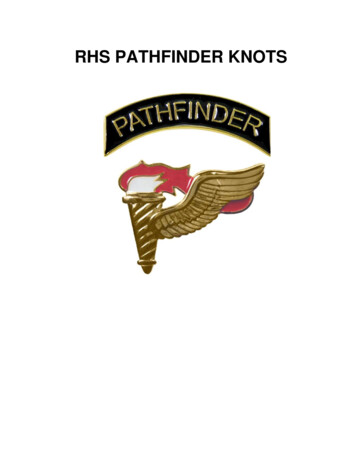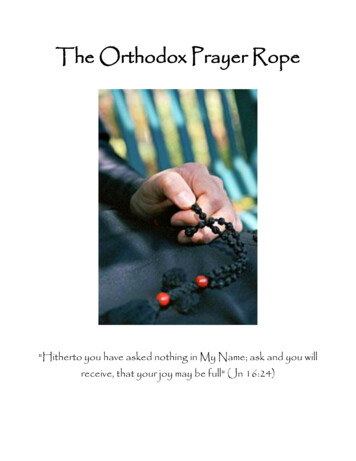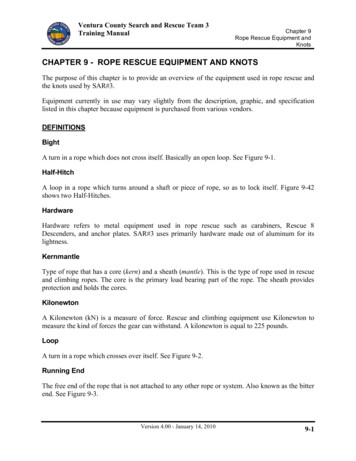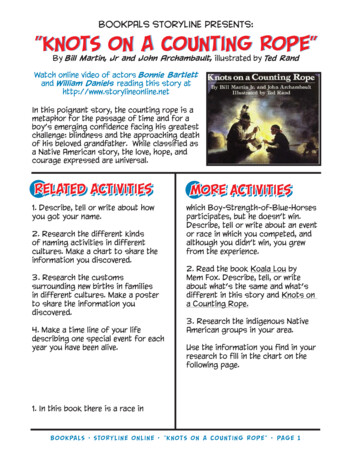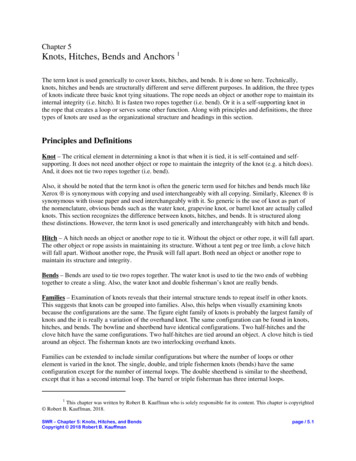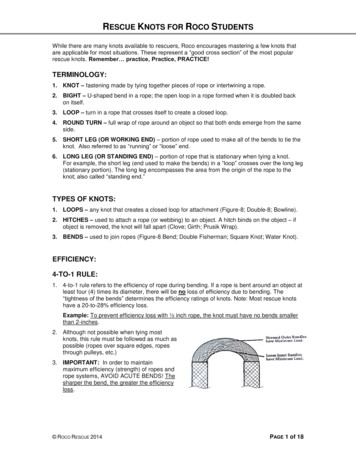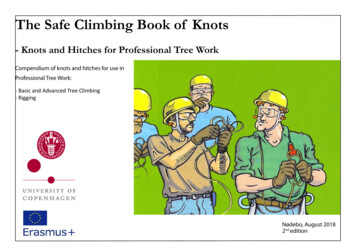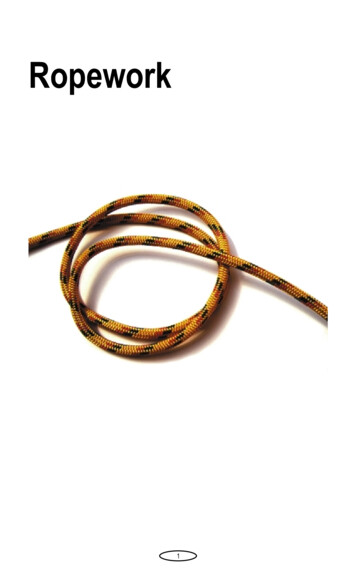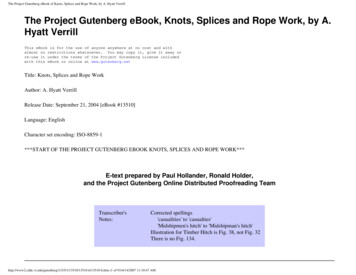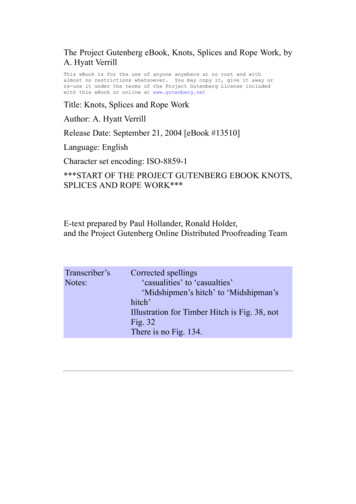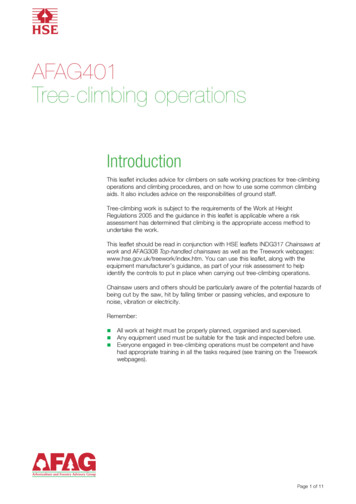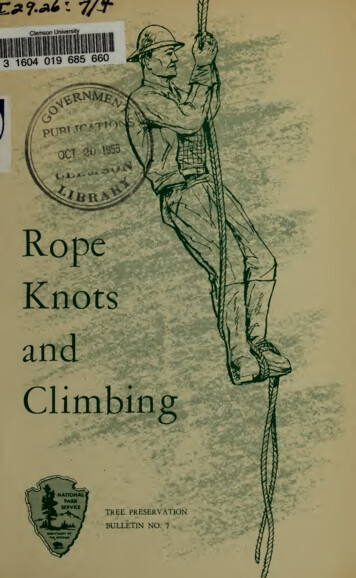
Transcription
C*%*ii7/*Clemson Uniyers6603 1604 019 685:/Knotsfand H jjClimbingTREE PRESERVATIONBULLETIN NO.7
RopeKnotsandClimbingThompsonby A. RobertForesterNational ParkTREE PRESERVATION BULLETIN NO.7 ServiceREVISED1955
4 cAUNITED STATES DEPARTMENT OF THE INTERIORDOUGLAS McKAY,SecretaryNATIONAL PARK SERVICECONRADForsaleL.WIRTH,Directorby the Superintendent of DocumentsU.S.Government PrintingWashington25,D. C.OfficePrice 15 centsV \* *3*
FOREWORDOver 20years ago the National Park Servicelem of improving and maintainingwas confronted with the prob-good condition thousands of valuableinshade, ornamental, or historically significant trees within a variety of areas.In order to guide thosewho weremost complete and usefulresponsible for thisseries ofworkinpark areas, anine Tree Preservation Bulletins wasprepared between 1935 and 1940 by the late A. Robert Thompson, foresterBranch of Forestry, National Parkin theNo.7,Although thebulletinsandthisbeing reissued from time to time to meet2,original bulletinthis series.were originally intended for park employees, theyreceived wide use by arboristsTheTheService.Rope, Knots, and Climbing, was one ofdemand hasTheycontinued.arethis need.The originalrevised series will total seven in number.Bulletins1andPurpose and Policy, which referred to National Park Service practicesonly, are being replacedby theplanting Trees and OtherSafety for Tree Workers.tices,earlier bulletinWoodyPlants,andNo.9,now No. 1, Transnow No. 2,bulletin No. 8,Bulletin No. 6, General Sprayingwas revised and reissuedin 1953and the newand Other Prac-bulletinNo.This bulletin, Rope, Knots, and Climbing, remains No. 7 in thefor veryminorrevisions,itisessentiallyunchanged from theBob Thompson's complete and expert knowledge1series.in 1954.Exceptoriginal, attesting toof the subject.ConradL.Wirth,Director.
CONTENTSPageIntroduction1Rope Manufacture1Working LoadsforManila Rope2Important Knots and Hitches3Important Splices6Throwing a Rope7Spurs or Climbing Irons9Rope Climbing9Safety SlingUseof SafetyInspection ofCoiling the13Rope in a Tree14Rope15Rope15Roping and Climbing Standards15Acknowledgments20Bibliography20
INTRODUCTIONAlthough technicians in many varied fields must be skilled in the use ofand methods of rigging, few have more daily need for suchskills than the tree worker.He uses rope to get into a tree; as an aid inrope, knots,in a tree; as a means of lowering and raising tools, maand lowering tree limbs; and, most important of all, as a safetymeasure which prevents him from falling.working aroundterials,Ladders often are useful in connection with tree preservationactivities,but they are awkward to transport and use and so usually are not availableAnd, even when ladders are used, thewhen needed.intelligentworkeralways will avail himself of a rope safety sling to prevent possible accidents.Ittreemaybe truthfully said that the ability to perform efficient work in abased firmly upon a thorough working knowledge of rope, knots,issplices, hitches,skilled unlessitand climbing technique.Notreeworker can be consideredhe possesses such basic knowledge and knowshowto applyproperly.skill with rope comes only with proper instruction and constant pracand cannot be obtained merely through reading. It is hoped, however,that this bulletin will serve a useful purpose in explaining some of the fundamentals of rope, knots, and climbing, and that it may be helpful up to aRealticecertain point in actual practice.ROPE MANUFACTURERopemade fromseveral materials, among which are manila, hemp,and nylon. Each of these types of rope has its properpurpose, but it is with manila rope that we are immediately concerned,since this has been found to be the most efficient type and probably themost generally used for tree preservation work.Manila rope usually is made from the fiber of the stalk of the wild bananaand is obtained principally from the Philippines. In the manufacture ofthe raw material into rope, the fibers are twisted into yarns which, in turn,are twisted into strands.Three or four strands are laid up into a rope,and sometimes several ropes are combined into a cable.iscoir, flax, cotton,Tocounteract the tendency to unlay, the successive twists are taken inYarns usually are made right-handed, strands lefthanded, and ropes right-handed. This twisting weakens the rope materially, at least one-third of the original strength of the fibers being lost.opposite direction.
:TREE PRESERVATION BULLETIN NO.ITheit istwisting adds considerably to the elasticity of the rope, however,andnecessary for usability.Itshould be clearly understood that rope does not have a permanentelastic limit,but due to the tendency of therope gradually losesstrains,is7anditmaybe seriously weakened by constant working.subjected to anything approaching a breakingpermanently, andupon one another,fibers to slipcohesion under the repetition of even moderateitsitmaystress, itsIf thestrengthisropereducedbe expected to break under a very moderate load.WORKING LOADS FOR MANILA ROPEUnder averageconditions the working load placed on a rope should notexceed one-sixth of the breakingropeisnew, the working loadUnder unfavorablebut under the best conditions,stress,maybe one-fourth of the breakingconditions where ropetreeworkistheused frequently and for anisindefinite period, as in the case of a climbing rope, thenot exceed one-eighth of the breakingifstress.Thestress.working load shouldbest rope for generaland 4-inchand wear longer.3-strand, long fiber, tightly twisted manila, in l/z-diameters which has been treated tomakeitresist rotNormally, 4-strand rope has about 95 percent of the breaking strength of3-strand rope and henceisnot so desirable.Federal specifications foring standards.new manila rope(3-strand) include the follow-This table should be used in estimating safe loads formanila rope used for tree rossweight ofof ounds5590200324Maximum MinimumMinimumlengthweightper 703.71.breakingSafe load(Y% 316751,125
:AND CLIMBINGROPE, KNOTS,IMPORTANT KNOTS AND HITCHESAlthough there are many knots and hitches which are useful in connectionwith tree preservationactivities, those illustrated in Plate Irepresent theusual knots for which a tree worker will have constant need.attentiontiepaid to the illustrationsisthe knotspersonwhoshown without personalBefore learning towhich themaycomments may beassistance of anotherinvaluable to the beginner.(commonsomeof value in suggestingnamesTheusage.of theways inmay be usedillustrated knotsand 5)figs. 1isused in place of a single bowline whereisneededas in a safety sling.be tied in the bight of a rope without using the rope ends.Taut-line hitchsling.isFigure 8 illustrates terms ingreater strength or increased bodily comfortmayTheinstruction.knots, the novice should clearly understand thetieBowline-on-a-bightItIf carefulbe possible for one to learn toknot tying, however,skilled inisof parts of a rope.followingit2)(fig.used by tree climbers as a safety knot for a bodyisshould be snugged tight before being used.Itunder Safety(See descriptionSling.)Running bowline3)(fig.isa convenient form of running loop.It isuseful for attaching rope to a high point in a tree after rope has been slungover a limbwhen working onCats- paw(fig.4)isthe ground.used for hooking a tackle to a rope.Itmaybe tiedin the bight of a rope without using the rope ends.Safety sling5)(fig.a bowline-on-a-bight tied into a safetyisor aline,standard tree worker's safety belt or saddle in combination with a taut-linehitch.A suitable safety sling should always be used while working in a tree.(See section on Safety Sling.)Bowlinecannotslip6)(fig.—one of the most useful knots.isItthe harder the pull, the tighter the knotforms a loop which—anditdoes notjameasily.Blackwall hitchFigure-of-eightSquare knot(fig.(fig.half -hitches9)10)two ropes of the sameSheet bend (fig. 11)Two7)(fig.isused as a safety stop in the end of a safety rope.isisused for hooking a tackle to an end of a rope.the simplestsize together.isand mostIt willnotuseful of knots for tyingslip ifropeisdry.used for tying together two ropes of different(fig.12) are used to tie thesizes.end of a rope arounditsMaybestanding part after passing around a limb or spar.Timberloosenedhitch(fig.13)isused for lowering limbs fromClove hitch(fig.14)isa generally useful knot tospar, or to raise tools into a tree.bight.trees.easily.Itmaytiea rope to a limb orbe tied on the end of a rope or a
5TREE PRESERVATION BULLETIN NO.PLATEICOMMON KNOTS AND HITCHESFIG.IBOWLINE ON A BIGHT(I)(2)-FIG.SAFETY SLINGFIG. 4CATS -PAWSTANDING PART VFIG. 7FIG.BLACKWALL HITCH9FIGURE-OF-EIGHTFIG. 8PARTS OF A ROPEFIG.FIG. 10SQUARE KNOTIISHEET BENDFIG. 12FIG. 13FIG. 14TWO HALF HITCHESTIMBER HITCHCLOVE HITCH7
ROPE, KNOTS,AND CLIMBINGPLATE3ECOMMON ROPE SPLICESFIG. 17FIG. 16FIG. 15EYE SPLICEEYE SPLICE(I)EYE SPLICE(2)FIG. 23FIG.FIG. 18STEEL MARLIN SPIKE(I)FIG. 19FIG."3.""*FIG. 21LONG SPLICEO-55 - 2(I)22LONG SPLICE33116120SHORT SPLICE(2)FIG.24HICKORY FIDSHORT SPLICESHORT SPLICE(3)(2)13)
TREE PRESERVATION BULLETIN NO.IMPORTANTTheSuchability to spliceoftenskilltwo ropes together is a useful onewhen no available ropea certain purpose.fulfillSPLICESinvaluableisWhento the tree worker.long enough toisthe diameter of the finished spliceno consequence, the simplest unionthe short splice, butiswhenof the finished union cannot be greater than that of the ropeThe latterblock.The eyemust be used.splicethrough a tacklefigs. 15, 16,ofitself,the longwhen the splice must passuseful when a permanent loopnecessaryisspliceisneeded in the end of a rope, such as in the attachment of a ropeThese splices are shown on Plate I and are formed as follows:eye splice (seeisthe diameterisThe7and 17)The ropeisto a ring.used for forming a permanentunwound and separatedfrom the end. The end is then broughtback against the body of the rope to form an eye of the size desired. Theloop must be formed entirely of tight rope and the separated (splicing)strands should extend beyond the point of juncture.The splice is thenformed by placing each splicing strand alternately over and under successive tight strands along the body of the rope away from the point of junctureand the eye itself. The splicing strands should be worked into the rope asloop in the end of a rope.(unlaid) for a length of about1strands arefootdescribed in the short splice.Theshort splicetogetherropeiswhen an(see figs.18,19,and 20)isused to join two ropesincrease in diameter at the spliceisnot important.Theunlaid for a short distance and the ends are brought together withmeshed alternately (or married) as shown. Eachworked back through the body of the adjoining rope end.This is done by placing it alternately over and under two tight strandsadjacent to it in the adjoining end. When the splicing strands have beenworked back past two tight strands they are trimmed to two-thirds theiroriginal diameter. The process is repeated and the strands are trimmed tothe splicing strandssplicing strandisone-third their original diameter.thirdandThelast time,spike or fidThe tuckingand the splice is completed.(see figs. 23 and 24) are usedprocessopentoisrepeated for thetight strands thussimplifying the splicing process.In making a longsplice, theropes are unlaid for a longer distance thanin the short or eye splice before the strands arestrand a x of ropeAismarried (seeunlaid for about a foot, and b risfig.21).Thelaid into the opening,B into A (see fig. 22a) For convenience theand b x should be twisted together as shown. Follow this sameprocedure by unlaying b 2 and lay a 2 into the opened lay of B and twisttogether as before.Then a 3 and b 3 should merely be twisted together.We now have three pairs of strands together at different points of the rope.thus working a strand ofstrands a x.
ROPE, KNOTS,ThenAND CLIMBINGstarting with b 2/and a 2 separate each strandtwoinparts, and, takingone-half of each strand, overhand knot these together as in Figure 22k andThetuck them in a short splice as shown in Figure 22m.andstrands (a xThen(a 3 b 3 )b )other pairs ofare similarly reduced, knotted,the spare half of each strandistrimmedoffsmootheach pair of strands have been tucked, thus completing theand tucked.after halves ofsplice.on a hard surface,such as a floor or sidewalk, and roll it back and forth under the foot. Thistends to make the splice smaller in diameter and also tends to equalize thetension on the various strands, thus making a stronger and firmer splice.Any loose yarns should be trimmed off so that they will not bind while theAfter any splicespliceismade,it isa good practice to layitpassing through a block.isTHROWING A ROPEAfter the various knots shown in Platestep to efficientsafety rope.in a treeisIare mastered, the next importanta thorough knowledge of the use of athe tree worker must know how it should be used to getand second, he must be able to manipulate it so he is bothFirst,into the tree;efficientworkandsafe all the timeheisoff theAground.safety rope should beone-half inch in diameter.TheThose whoand follow them.following descriptions apply to right-handed persons.are left-handed should reverse the directions as they readWhenis uncoiled, checked, and laid out on the ground, a throwformed as shown in Figures 26 and 27. This knot is for thepurpose of forming a weight on the end of the rope so that the rope can beslung through a crotch and the end returned to the ground.The knot isformed by making 8 or 10 loops about 8 or 10 inches long in the hand, thenwrapping the loops with about 8 turns, and pulling the bight of the ropeing knotthe ropeisThe knotthrough the upper portion of the loops.compactso that there will benoIn throwing the rope, the bight held in theitleftshownAon branches or twigs.hand is adjusted so thatground when the arm is straight (see fig. 27)Then 5 orthe same length. The knot and 1 or 2 loops are held inhand, and the balance of the loops are held in the left hand asjust reaches the6 loops arethe rightshould be kept tight andloose loops to catch.madein Figure 28.well-placed wide crotch free of obstructing twigs or branchesselected.If possible, the crotchisthenshould be near the trunk and one branchabove the one where the climber desiresto stop.Safety ropes should neverbe slung over dead or badly decayed limbs.Whenthrowing the rope, the climber should stand facing the tree at apoint which will allow a free throw of the rope through the crotch.With
TREE PRESERVATION BULLETIN NO.Figure 25.Figure 27.—Inspecting rope.—Throwing knot, secondFigure 26.position.—Throwing knot,Figure 28.first—Ready7position.to throw.
AND CLIMBINGROPE, KNOTS,b the right knee bent and the weight carried on the right leg, the arms shouldswing forward and back together to get momentum.the righthand shouldrelease theOnthe last swing,throwing knot, and the rope in theleftaimed properly, it willgo through the crotch and the throwing knot will fall on the other side.The knot should then release itself and the rope end fall toward the ground.Sometimes the end will reach the ground. If not, it will be necessary tothrow running coils up the rope to whip it over the branch, or a pole prunerused to hook down the short end of the rope. Care must be exercised toprevent pulling the rope back through the crotch.hand should bereleased loop by loop.If the lowest crotch possible torope, a smaller ropesmall ropeisreachIf theisistoo high to sling a J/2-inch diametermay be thrown within position, therope/2 -inch ropeWhena weight on the end.maythethen be tied on and pulledthrough the crotch.SPURS OR CLIMBING IRONSAs a generallive trees.rule,climbing irons or spurs should not be used in climbingSkilled shade tree workers gaveup the useof such implementsyears ago.The actual mechanical injury to trees caused by spurs is probably ofminor importance compared with what may be termed the secondary effect.The holes left by the sharp-pointed spurs are ideal "open doors" for fungusinfection in thin-barked trees, and as harbors for injurious insects.Climbing irons are doubtless a necessity to the utility linemen who climbbare poles, but they are definitely hazardousspurs are difficult tocausing aimbedwhen used onin certain types of barktrees, sinceand mayslip,thethusfall.ROPE CLIMBINGUse of Legs Around TrunkAfter the ropeclimbing theistree.hand, and wrap theTouse thisproperly crotched, there are several ways of usingThelegsmethodsimplestisitinhands and arms, hand overa fulcrum and support.to use thearound the trunkasof climbing, the double ropeisbrought together andthe climber reaches as high as possible, grasping both ropes as shown inFigure 29. Then, with the weight supported by the hands, the legs arelifted as30.high as possible and wrapped around the trunk as shown in Figureis then climbed hand over hand, still keeping the legs wrappedThe ropetightlyaround the trunk.Whenthe positionshownin Figure 31isreached,
TREE PRESERVATION BULLETIN NO.10Figure 29.—ReadyFigure 31.to climb.—Hand over band.Figure 32.— Up onto limb.7
AND CLIMBINGROPE, KNOTS,11the legs are released and again lifted as high as possible to a new positionon the trunk. This process is continued until the crotch is reached.a limbIfisencountered before the rope crotchsuch a limb.easily transfer himself tocanIfclimb directly onto the limb where the ropeapproachedasshownup and hooked overlegin Figure 32.Inthe limb, whichisreached, the climbernecessary, however, tocrotched, the limbthis position the right legmayisThe bodyisbeswunggrasped by both hands, and theused as a brace against the trunk.isisisit isleftthen swung up andover the limb.If necessary toclimb higher by using the rope, one rope endinto a throwing knotclimbing process repeated.to serve as footisrecoiledand again thrown through a favorable crotch and theUsually, however, there will be sufficient limbsand handholdso that the treeThe rope end should be knotted overcarried up as the tree is climbed.can be climbed as a ladder.the shoulder or through the belt andUse of FootlockItisoften necessary to climb a ropeInto assist.this case thewhenthe tree trunk cannot be usedrope should never be climbed hand over handExperienced climberswithout using the footlock.willhave their ownpreferred form of footlock, but for others the following footlockasissuggestedan acceptable and proven standard:With the double rope hangingfree, theclimber should grasp the tworopes as high as possible and raise the body with the arms.Thenthe rightknee should be raised with the ropes passing outside the right thigh, backof the right leg, over the right instep,ThenFigure 33.theleftfootisraisedand over the left instepand placed on the rightasshownininstep, lock-arch and the right instep as in Figure 34.Inthis position the entireweight of the climber should be borne by thefeet.Thenshown in Figure 35 to a new grasp of theand the legs raised and locked as before.Thising the rope between theleftthe arms are raised asthe footlock released,processone legmay beisThe roperepeated as often as necessary.thrown overisitWhenthe limbisropes,reached,and the body swung over and onto the limb.then carried higher in the tree as described previously untilthe final crotch for the safety slingisreached.In order to work freely anywhere in thetree, the highest safe centralcrotch should be selected through which to sling the safety rope.Acrotchand a 3-inch side branch issufficient to hold the heaviest climber if the limbs are alive and undecayed.Tight crotches should be avoided as they may bind the rope and causeconsiderable difficulty when it is necessary to change the adjustment of theconsisting of a sound 5-inch upright branchsafety sling.
TREE PRESERVATION BULLETIN NO.12Figure 33.—Footlock,Figure 35.—Footlock, thirdfirstposition.position.Figure 34.Figure 36.—Footlock, second—Safetysling.position.7
ROPE, KNOTS, AND CLIMBINGCramps and13avoided when using the footlock asThe climber should stop and rest if hestrains should beas in other types of climbing.Thetired.careful climber will not use the footlockFor higher climbs, hegreater than 20 to 30 feet.methodmaytiewellfeelsfor a climba bowline-on-abight in one end of the rope and raise himself by hauling on the other end.Theassistance ofcases.butone or two fellow workersThis procedureit is feltwillmay sound cumbersomebe found helpful in suchto the trained tree worker,to be a necessary safety precaution for high climbs, especiallymen.in the case of relatively inexperiencedSAFETY SLINGThere areseveral safety beltsfor use by tree workers.aspecial-made safetymake upandspeciallymadesafety slings availablebowline-on-a-bight, tied into a safety line, orbelt, orsaddle in combination with a taut-line hitchthe safety sling.Since this bulletinrope-typesling,In formingtoAform aisconcerned primarily with the use of rope, only thethe bowline-on-a-bight,bight.Aiscovered in detail here.one end of the ropethis sling,bowline-on-a-bightfree about 2 feet of the short end.Theisisdoubled back about 8then tied inthisfeetloop leavingexact size of the bowlineisdeter-mined by the size of the person to use it, and it shouldAfter the knot is tied, thefit snugly around the hips.loops are placed around the body as shown in Figure36.Theend of rope protruding from the bowlinethen tied into a taut-line hitch aroundthe ground rope as shown in Figure 2 and Figure 37 asfollows: About 6 inches from the bowline knot, wrapthe short end counterclockwise twice around theground rope, making the secondary wrap below theThen, continuing in the same direction aroundfirst.shorton-a-bightthe rope,ismake2 turnsabove thefirst 2,Whenfeeding theend under the short cross rope.wraps should be with reference to the time of wrapping No. 3 on top, No. 4 next, No. 1 next, and No. 2at the bottom. With the knot tied and tightened, theAlwayssling should be tested before swinging free.tie a figure-of-eight knot in the ground end of thesafety rope to prevent the end from being pulled accompleted, the—cidentally through the taut-line hitch.Swing board.Someclimbers,whenpruning, use the rope end
TREE PRESERVATION BULLETIN NO.14which protrudes from theIning.this case, thetaut-line hitch for holding acan of wound7dress-rope should be doubled back for about 15 feet beforetying the bowline-on-a-bight.Thiswill allow4 to 6 feet of the rope to hangbelow the knot on which the paint can may be hooked.If the climber expects to spend a long time in one position in the tree,the substitution of a swing board (see fig. 37) for the bowline-on-a-bightwillWhenbe found more comfortable.a swing boardisused,it isheld inplace by a single bowline strung through the holes at the ends of the boardand the bowline knot should beas close to thebodyTheas practical.bowline and swing board are, of course, supported by the taut-line hitchas in a standard safety sling.board,itshould beIn order to prevent splitting of the swingmade with twocross cleats underneath.USE OF SAFETY ROPE IN A TREEAmajor uses to the climber. It is the most conaround in a tree; it is a vital safety device; and theground end of the rope may be used to haul up light tools and equipment.In getting around in the tree, an efficient climber will allow his weightto be supported by the rope most of the time and use the limbs of thetree merely as guides.In this manner he can go out to the very ends oflateral branches, since his weight is carried by his rope, and the stress onthe branch is endwise and not downward.As the climber moves about in the tree, it will be necessary to readjustsafety rope has threevenientwayto getTothe taut-line hitch in order to reach the desired points.the knot should be jerkedWhenit isdownward andreleaseddesired to shorten the safety rope or tolower the body,when you want totake up slack, thestop.taut-can be worked upward by transferring the weight of the bodyfrom the hitch to a point above it. By holding the weight by a hand abovethe hitch and by the feet below the hitch, using a footlock, the hitch canbe slipped upward.The safety rope is the climber's guarantee against falling from the tree.The safety sling must be kept tied and in use until the climber is again onthe ground.To release the taut-line hitch before coming out of a tree isan unsafe and ill-advised practice.In pulling tools up into the tree or in lowering them, extreme care mustline hitchbe used with sharp-edged tools so that they will not cut the rope or injurethe climber.Thebest knot withor other handled toolandisisreadily untied.whichto attach a pole pruner, pole saw,the clove hitch.A commonThis knotiseasily tied,cause of injury to safety ropesisissafe,theby inserting a hook in a loop in the rope. Thehandle often catches on a limb, thus closing the cutter on the rope withraising of pole pruners
.AND CLIMBINGROPE, KNOTS,consequent damage.15Care should be exercised constantly against personsstanding under the treewhenbeing raised or lowered.tools areINSPECTION OF ROPERope should be keptwhen notcoiledin useand should be thoroughlyIf oneinspected for wear, cuts, and abrasions before being used again.strand ormoreiscut or badly worn, the rope should be discarded or theabrased portion cutoff.Since the exterior appearance of a rope does not always revealitstrueopen the strands of the rope at intervals to observethe condition of the inside fibers.If these are broken appreciably or if dustis found in quantity, the rope is probably materially weakened and shouldcondition,it iswell tobe discarded.COILING THE ROPEArope must always be kept coiledwhennot in use.Itisa sign ofignorance and carelessness to allow a rope to be put away without coilingitproperly.Anefficientmethodof coiling a ropeThe rope may be looped over15 feet areleft.straightened.illustrated in Figures 38 to 40.isthe left arm, asshownin Figure 38, untilaboutCareful watch should be kept for kinks which should beThen, starting about a foot from the top of thecoil,the endshould be wrapped about 6 times around the loops by rolling them in thehand as shown in Figure 39. Then the left hand is extended through asshown in Figure 40, and the bight is pulled back through the loops. Twohalf-hitches are then tied around the bight, leaving a short end for carryingleftor tying to a peg or support bar(seefig.41)ROPING AND CLIMBING STANDARDSThefollowing standards and restrictions are created solely as afrom injury.thoroughly understood and followed.of protecting tree workers1.The standardsafety ropediameter, manila rope notlength.Theisless/2-inch nylon ropeEach oneismeansimportant and must bea first-grade, 3-strand, rot-treated,/2 -inchthan 120 feet and preferably 150 feet iniscominginto wider useandisacceptable
TREE PRESERVATION BULLETIN NO.16Figure 38.first—Coiling rope-position.—Figure 40. Coiling ropethird position.—Figure 39. Coiling ropesecond position.——Figure 41. Coiling ropefourtb position.7
.AND CLIMBINGROPE, KNOTS,ropeas a standardif17Inexpensive substandard rope should bepreferred.avoided.2.ifThesafety sling should always be used whilea ladderisMany men have beenalso used.workingin a treeevenbadly injured or killed bynot observing this cardinal rule.3.Every rope must be thoroughly inspected for cuts or abrasions beforeDon't hesitate to cutuse.off aweak end orDon't "burn" a rope by loweringto discard questionable rope.too rapidly, and use care againstitdropping cigarettes on ropes.4.The ground endof a safety rope should not be left dangling overmust be kept free from obstructions.5. A rope must not be climbed hand over hand without using a footlockor using the legs around the tree. "Shinning" more than 15 feet up a treeis an unsafe practice.Climbs over 30 feet should be made by using aAvoid fatigue or cramps.safety sling.If it becomes necessary6. All slack must be kept out of the safety rope.to change the supporting crotch of a safety sling, the climber should useTo be absolutely safe, the climbergreat care while changing crotches.should tie himself to a convenient limb while making the change.7. All rope must be kept coiled when not in use.Rope deterioratesrapidly when it is saturated with water and improperly dried, so unnecessaryroadways, anditRope should not be allowed to freeze afterRope should not be left in a treereason to expect rain, or where it might be damagedwetting should be avoided.wetting, as frozen rope breaks easily.overnightwhenthereisor stolen.Rope should not be dragged alongthe ground, over rough surfaces,and sharp bends over unyielding surfaces should be avoided.Rope should never be stored or transported where sharp tools may cut it.9. Kinking is one of the main causes of injury to manila rope and should8.or acrossitself,be avoided, especiallywhen10.day.whenthe ropeiswet.Tofrom the inside of the coilAll knots should be removed from a ropeuncoiling, uncoilToavoid kinks innew rope—never from theat theleave knots tied for a prolonged period willoutside.end of a workingcause kinking andundue wear.1 1Except under exceptional circumstances,or worked inwhenwet.Itishold on slippery bark, and knots are apt to12.Remember: A goodaccident insurance policysafety rope—usetrees should notbe climbedimpossible to get a good foothold or hand-it.isslip ifthe ropeiswet.the tree worker's most important
1,TREE PRESERVATION BULLETIN NO.18XO.NOcOC"ft!yG5'o"f ,eg. XcOX!yCCOcoLONO00 ,COT—ir cNioor oocor--oocot r cOLncNr coco, en,—00 0000r00 COCNt CO 00 NOt,'(»O0\00inOMrt00*00HifliOUl( lnlflrHO-c cOcOCNcOcO''tf-cOcOcOcOcOcOcOcON-N-' 4-cOcOcOI-,-c rj-ovO' -T- NOCNooTfi-i' -cx5T-ii-HOoor - O*r t iOT c\c t T t co --iT-iCNCNr -T--iCNCNT--ico CiOOcnor -T-iioir)or oioi -t -iO' -cNr in —iK«JcOCNCNcOcNcOCNCNcOCNcOCNCNCNcOcOcOcNCNcO OLnoinunovo —i oinT-cintnTj-c\c\Ln' —OhtOOOTtaNMN vONTt rH oO Nhh JCNCNCNCNCNCNCNCNCNCNCNCNCNCNcOCNCNCNCNCN u- s'oiuVooCNflXo ininOr
rope,knots,andclimbing / Then starting with b 2 and a 2 separate each strand in two parts, and,taking one-halfof e
